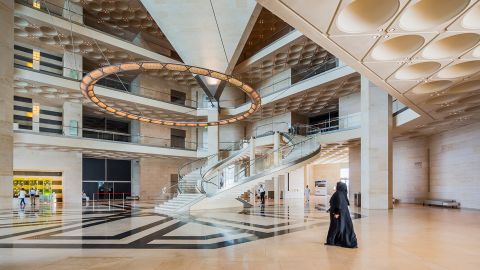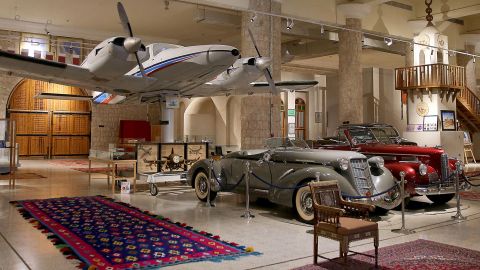Qatar hasn’t only been busy building soccer stadiums but also a slew of architecturally striking and accessible museums in its well-documented quest to be recognized as the arts capital of the Arabian Peninsula. Qatar travel guide.
Most of the Gulf nation’s major museums have opened or been renovated during the past decade, with three additional art institutions scheduled to expand Qatar’s cultural offerings by 2030: the Lusail Museum showcasing Qatar Museums’ Orientalist collection; the Art Mill Museum focused on contemporary art; and the Qatar Auto Museum celebrating the nation’s obsession with luxury cars.
Public art, too, continues to proliferate, with US sculptor Jeff Koons’ colossal “Dugong” among 40 new public works installed across Doha in 2022.
Here are some of of Qatar’s best museums to visit now:
Museum of Islamic Art

Acclaimed Chinese-American architect I. M. Pei was reportedly coaxed out of retirement to design the building that would announce Qatar’s arts-hub intentions to the world upon its 2008 opening.
A gleaming white Cubist confection rising out of Doha Bay like a geometric wedding cake atop its own man-made island, Doha’s Museum of Islamic Art (MIA) remains one of the city’s most recognizable buildings.
Inside is what’s thought to be the world’s largest collection of Islamic art spanning 1,400 years and three continents.
Reopened in 2022 following an 18-month renovation, the carbon-neutral museum’s reimagining introduces a visitor trail with expanded interpretative materials providing previously-lacking context to its vast collection of manuscripts, ceramics, textiles, woodwork, jewels and other treasures.
The galleries dedicated to Islam in China and Southeast Asia are new. Mobile and child-friendly resources make MIA more accessible for families, buoyed by free entry for kids 16 and under. Free museum tours run daily, with themes ranging from calligraphy to carpets.
MIA also houses a library with more than 21,000 books on Islamic art, while French culinary legend Alain Ducasse’s Mediterranean restaurant IDAM occupies the top (fifth) floor. A footbridge connects the museum to MIA Park, home to some impressive public artworks of its own.
National Museum of Qatar

Characterized by giant interlocking discs mimicking the intricate crystal clusters known to “bloom” in the Qatari desert, the National Museum of Qatar (NMoQ) is one of the country’s most iconic buildings. While it may seem like you’ll need all day to explore the Jean Nouvel-designed museum occupying a vast swath of Doha’s historical center, its exhibition halls occupy only a fraction of the structure.
Opened in 2019, the NMoQ’s 11 interconnected galleries tell the story of Qatar from its geological formation some 7 billion years ago to the oil-rich nation of 2.6 million residents today. Films help to bring many of its expertly curated exhibits to life, with audio guides designed to be used both in the museum and at home.
The discovery of oil in 1939 that launched Qatar’s industrial development propels exhibits into the modern era, with possibly the most controversial envelope in sporting history – revealing Qatar as the host of the 2022 FIFA World Cup – among the artifacts on display.
But the NMoQ experience doesn’t end there, with the visitor trail continuing outside to the restored original palace of Sheikh Abdullah bin Jassim Al Thani, who ruled from 1913-1949 as the third emir of Qatar. There’s not much to see inside the modest structure, yet the traditional building offers a rare glimpse into a bygone era.
It would be remiss to bypass the gift shop, where undulating wooden surfaces that mimic the museum’s organic form give this surreal space a cave-like feel. The museum also has an Alain Ducasse restaurant, Jiwan, where camel rissoles are known to grace the contemporary Qatari menu.
Msheireb Museums
Doha’s historical core was controversially razed to construct the city’s ultra-modern Msheireb Downtown district in the early 2010s. Fortunately, four neighboring heritage homes were spared by the bulldozers and now house Msheireb Museums, one of Doha’s most interesting free attractions.
The largest of the four museums, Bin Jelmood House, also explores the most compelling subject matter: slavery and the exploitation of human labor. While Qatar’s role in both is largely focused on the past, the subversive space nonetheless forces visitors from the Gulf and beyond to reckon with historical human rights abuses that continue into the 21st century.
Next door is Company House, an ode to Qatar’s petroleum industry, from where a side door leads to the smaller and more interesting Radwani House. Built in the 1920s, it has been furnished to present a window into traditional Qatari family life during that era. Across the road, Mohammed Bin Jassim House hones in on Doha’s architectural heritage, particularly the redevelopment of Msheireb.
Mataf: Arab Museum of Modern Art
A great excuse to explore Doha’s futuristic Education City precinct, the Mataf: Arab Museum of Modern Art is home to the world’s largest collection of modern and contemporary Arab art.
Flanked by a sculpture garden, the museum building is somewhat unremarkable for a Qatari arts institution. But Mataf was never meant to be permanent, with French architect Jean-François Bodin recruited to transform a former school to temporarily house a collection assembled over three decades by Sheikh Hassan bin Mohamed bin Ali Al Thani, a cousin of the emir of Qatar, Sheikh Tamim bin Hamad Al Thani.
Opened in 2010, Mataf’s 12 galleries occupy two floors, with galleries 1-7 featuring temporary exhibitions and 8-12 showcasing a rotating selection of works from the museum’s 9,000-strong permanent collection.
Major themes explored in exhibits include the aesthetics and politics of change and progress, from the development of the Middle East’s petroleum industry to the role of women in Arab society.
Lightening the mood are color-popping geometric works by Moroccan painter Mohamed Melehi and Lebanese artist Gebran Tarazi (both found in Gallery 11), with the museum’s cavernous entrance featuring a huge screen onto which video works are typically projected.
Sheikh Faisal Bin Qassim Al Thani Museum

Where do billionaires keep all their toys? If you’re the chairman of one of Qatar’s biggest conglomerates, you build an enormous, fort-inspired museum in the middle of the Qatari desert and graciously open it to the public.
Easily Qatar’s quirkiest museum, the Sheikh Faisal Bin Qassim Al Thani Museum (FBQ Museum) is an Aladdin’s cave of historical artifacts collected from four continents. At times they’re confusingly displayed alongside amateur-looking artworks and random curios – a lack of interpretative information leaves much to the imagination here.
Hilton Salwa: The gigantic luxury hotel in the middle of nowhere
Yet there are plenty of gems to be discovered, including an impressive collection of Qurans and a traditional Damascene home featuring exquisite tiling and latticework.
Visitors looking for the Saddam Hussein room will find the contentious exhibition is no longer open to the public. But classic car fans won’t be left disappointed, with around 300 vehicles from the sheikh’s immense collection now showcased in an enormous new wing.
While a significant investment in curation would serve the main museum well, the opportunity to peek inside the coffers of one of the world’s 3,000 richest people makes it well worth the 30-minute Uber journey from Doha’s city center.
3-2-1 Qatar Olympic and Sports Museum
It’s not difficult to guess which other major international sporting event Qatar has its sights on hosting at the Qatar Olympic and Sports Museum. Opened in the lead-up to the 2022 FIFA World Cup, the spiral access building is encircled by five rings that glow red, green, white, yellow and blue at night.
Attached to Khalifa International Stadium, the museum’s seven galleries begin with a history of sport dating back to the eighth century BCE, complemented by an array of intriguing artifacts.
Sports fans are guaranteed to geek out in the Olympic gallery. Displays include a pair of boxing gloves worn (and signed) by Cassius Clay (later known as Muhammad Ali) during qualifying rounds for the US Olympic team in the lead-up to the 1960 Summer Olympic Games in Rome, where the then-18-year-old heavyweight boxer won gold.
Then there’s the Hall of Athletes, which charts the legacies of 90 athletes who have left an indelible mark on modern sport – from household names like Usain Bolt and Pelé to lesser-known legends like French windsurfer Antoine Albeau and Swiss Paralympic cyclist Heinz Frei.
Donning activewear is recommended for making the most of the final section, the Activation Zone, where visitors are invited to strap on a 3-2-1 wristband and work their way through 18 interactive stations designed to measure their “physical literacy.”
After completing challenges spread across six themed spaces, including the “desert,” where pushing a 4WD out of a faux sand dune is designed to test upper-body strength, participants can swipe their wristband at a kiosk to collect a personalized profile identifying key physical and mental attributes.
The theme continues to the top-floor casual fine-dining restaurant Naua, where Michelin-starred English chef Tom Aikens has developed a healthy gourmet menu.

